lock FIAT SCUDO 2012 Owner handbook (in English)
[x] Cancel search | Manufacturer: FIAT, Model Year: 2012, Model line: SCUDO, Model: FIAT SCUDO 2012Pages: 219, PDF Size: 4.13 MB
Page 27 of 219
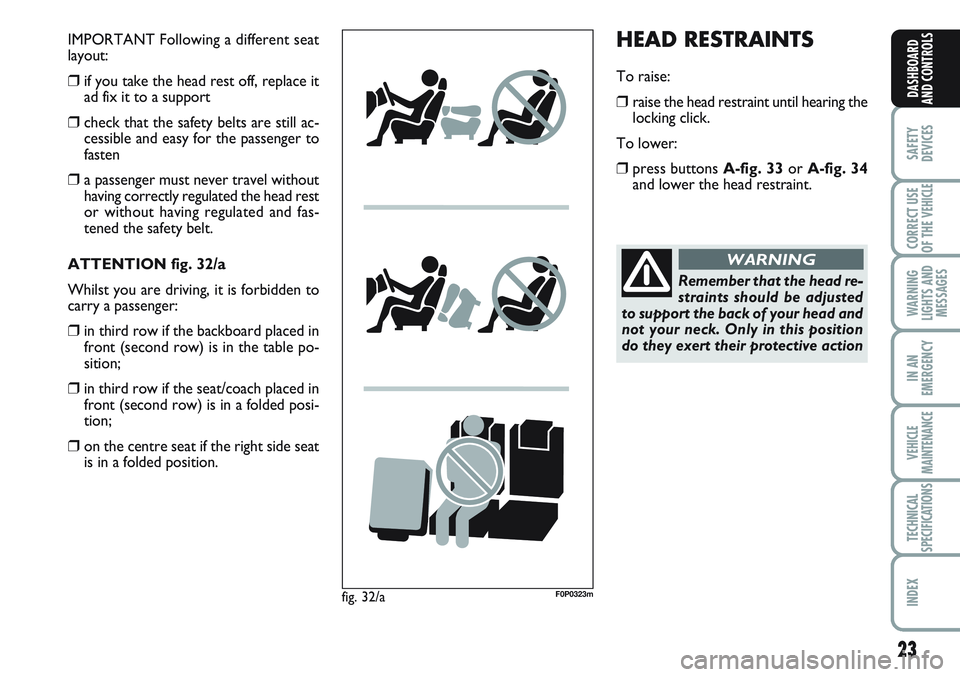
23
SAFETY
DEVICES
CORRECT USE
OF THE
VEHICLE
WARNING
LIGHTS AND
MESSAGES
IN AN
EMERGENCY
VEHICLE
MAINTENANCE
TECHNICAL
SPECIFICATIONS
INDEX
DASHBOARD
AND CONTROLS
HEAD RESTRAINTS
To raise:
❒raise the head restraint until hearing the
locking click.
To lower:
❒press buttons A-fig. 33or A-fig. 34
and lower the head restraint.
Remember that the head re-
straints should be adjusted
to support the back of your head and
not your neck. Only in this position
do they exert their protective action
WARNING
IMPORTANT Following a different seat
layout:
❒if you take the head rest off, replace it
ad fix it to a support
❒check that the safety belts are still ac-
cessible and easy for the passenger to
fasten
❒a passenger must never travel without
having correctly regulated the head rest
or without having regulated and fas-
tened the safety belt.
ATTENTION fig. 32/a
Whilst you are driving, it is forbidden to
carry a passenger:
❒in third row if the backboard placed in
front (second row) is in the table po-
sition;
❒in third row if the seat/coach placed in
front (second row) is in a folded posi-
tion;
❒on the centre seat if the right side seat
is in a folded position.
fig. 32/aF0P0323m
Page 28 of 219

STEERING WHEEL
The driver can adjust the steering wheel
position both axially and in height.
To adjust the armrests proceed as follows:
❒release the lever A-fig. 35pushing it
forwards (position 2);
❒adjust the steering wheel as required;
❒lock the lever Apulling it towards the
steering wheel (position 1).fig. 35F0P0028m
Any adjustment of the steer-
ing wheel position must be
carried out only with the vehicle sta-
tionary and the engine turned off.
WARNING
It is absolutely forbidden to
carry out whatever after-
market operation involving steering
system or steering column modifica-
tions (e.g.: installation of anti-theft
device) that could badly affect per-
formance and safety, cause the lapse
of warranty and also result in non-
compliance of the vehicle with ho-
mologation requirements.
WARNING
24
SAFETY
DEVICES
CORRECT USE
OF THE
VEHICLE
WARNING
LIGHTS AND
MESSAGES
IN AN
EMERGENCY
VEHICLE
MAINTENANCE
TECHNICAL
SPECIFICATIONS
INDEX
DASHBOARD
AND
CONTROLS
fig. 33F0P0026m
fig. 34F0P0027m
To optimise head restraint protective ac-
tion, adjust the seat back upright and keep
your head as close as possible to the head
restraint.
Page 43 of 219
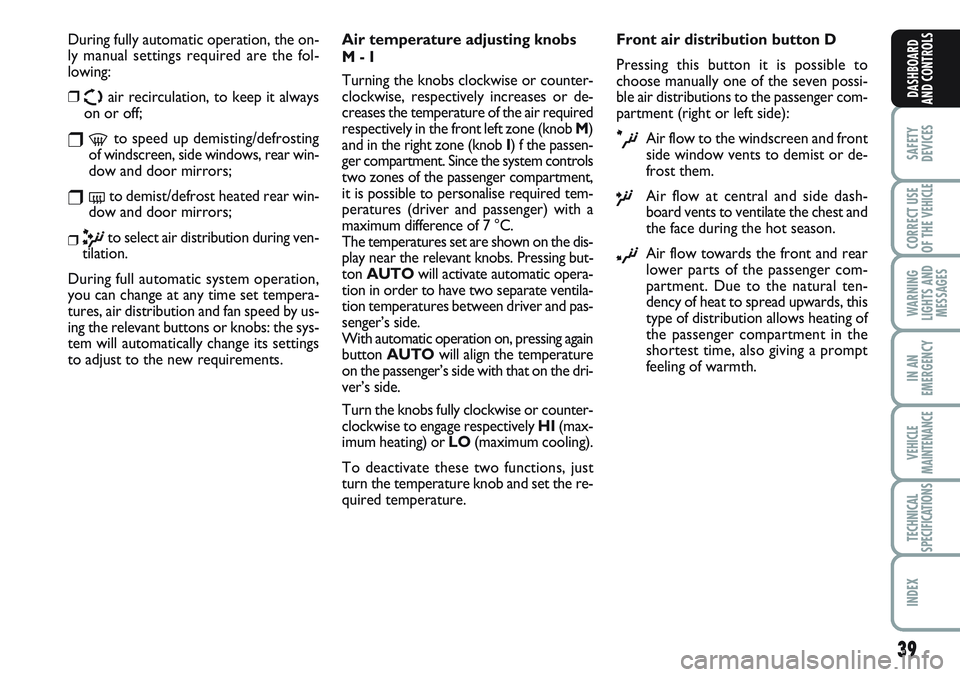
39
SAFETY
DEVICES
CORRECT USE
OF THE
VEHICLE
WARNING
LIGHTS AND
MESSAGES
IN AN
EMERGENCY
VEHICLE
MAINTENANCE
TECHNICAL
SPECIFICATIONS
INDEX
DASHBOARD
AND CONTROLS
During fully automatic operation, the on-
ly manual settings required are the fol-
lowing:
❒Ωair recirculation, to keep it always
on or off;
❒-to speed up demisting/defrosting
of windscreen, side windows, rear win-
dow and door mirrors;
❒(to demist/defrost heated rear win-
dow and door mirrors;
❒πto select air distribution during ven-
tilation.
During full automatic system operation,
you can change at any time set tempera-
tures, air distribution and fan speed by us-
ing the relevant buttons or knobs: the sys-
tem will automatically change its settings
to adjust to the new requirements.Air temperature adjusting knobs
M - I
Turning the knobs clockwise or counter-
clockwise, respectively increases or de-
creases the temperature of the air required
respectively in the front left zone (knob M)
and in the right zone (knob I) f the passen-
ger compartment. Since the system controls
two zones of the passenger compartment,
it is possible to personalise required tem-
peratures (driver and passenger) with a
maximum difference of 7 °C.
The temperatures set are shown on the dis-
play near the relevant knobs. Pressing but-
ton AUTOwill activate automatic opera-
tion in order to have two separate ventila-
tion temperatures between driver and pas-
senger’s side.
With automatic operation on, pressing again
button AUTOwill align the temperature
on the passenger’s side with that on the dri-
ver’s side.
Turn the knobs fully clockwise or counter-
clockwise to engage respectively HI(max-
imum heating) or LO(maximum cooling).
To deactivate these two functions, just
turn the temperature knob and set the re-
quired temperature.Front air distribution button D
Pressing this button it is possible to
choose manually one of the seven possi-
ble air distributions to the passenger com-
partment (right or left side):
æAir flow to the windscreen and front
side window vents to demist or de-
frost them.
øAir flow at central and side dash-
board vents to ventilate the chest and
the face during the hot season.
¿Air flow towards the front and rear
lower parts of the passenger com-
partment. Due to the natural ten-
dency of heat to spread upwards, this
type of distribution allows heating of
the passenger compartment in the
shortest time, also giving a prompt
feeling of warmth.
Page 58 of 219
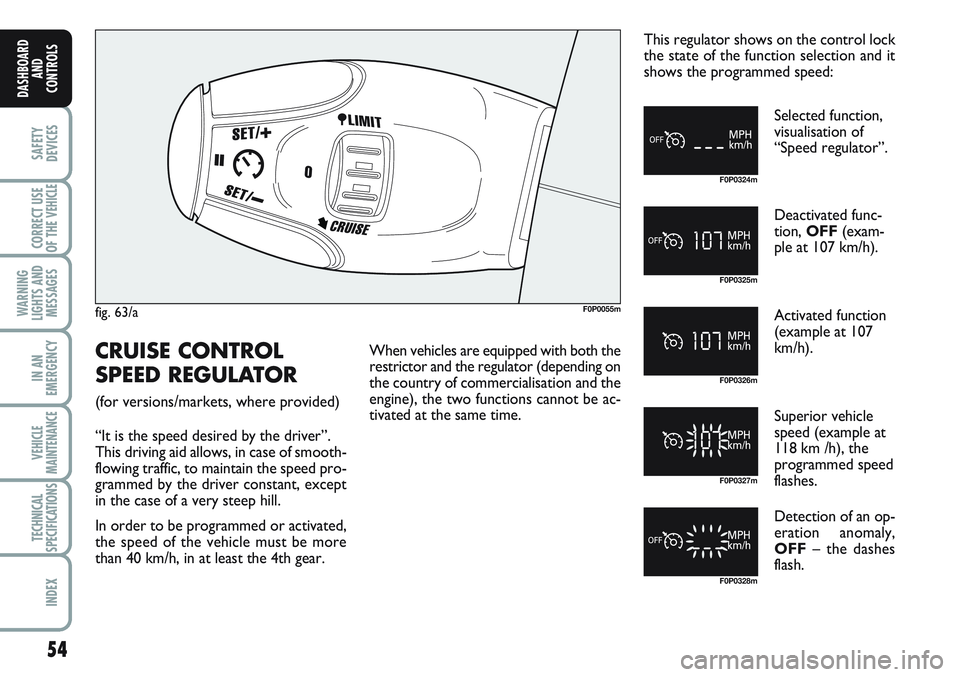
54
SAFETY
DEVICES
CORRECT USE
OF THE
VEHICLE
WARNING
LIGHTS AND
MESSAGES
IN AN
EMERGENCY
VEHICLE
MAINTENANCE
TECHNICAL
SPECIFICATIONS
INDEX
DASHBOARD
AND
CONTROLS
fig. 63/aF0P0055m
F0P0324m
F0P0325m
F0P0326m
F0P0327m
F0P0328m
CRUISE CONTROL
SPEED REGULATOR
(for versions/markets, where provided)
“It is the speed desired by the driver”.
This driving aid allows, in case of smooth-
flowing traffic, to maintain the speed pro-
grammed by the driver constant, except
in the case of a very steep hill.
In order to be programmed or activated,
the speed of the vehicle must be more
than 40 km/h, in at least the 4th gear.When vehicles are equipped with both the
restrictor and the regulator (depending on
the country of commercialisation and the
engine), the two functions cannot be ac-
tivated at the same time.This regulator shows on the control lock
the state of the function selection and it
shows the programmed speed:
Selected function,
visualisation of
“Speed regulator”.
Deactivated func-
tion, OFF(exam-
ple at 107 km/h).
Activated function
(example at 107
km/h).
Superior vehicle
speed (example at
118 km /h), the
programmed speed
flashes.
Detection of an op-
eration anomaly,
OFF– the dashes
flash.
Page 61 of 219
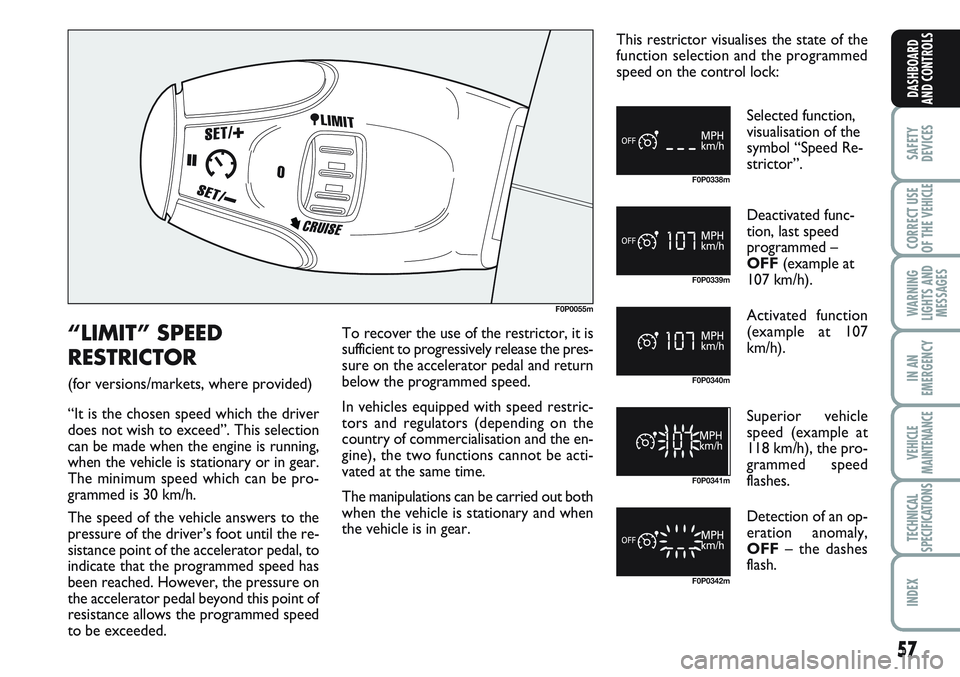
57
SAFETY
DEVICES
CORRECT USE
OF THE
VEHICLE
WARNING
LIGHTS AND
MESSAGES
IN AN
EMERGENCY
VEHICLE
MAINTENANCE
TECHNICAL
SPECIFICATIONS
INDEX
DASHBOARD
AND CONTROLS
F0P0055m
F0P0338m
F0P0339m
F0P0340m
F0P0341m
F0P0342m
“LIMIT” SPEED
RESTRICTOR
(for versions/markets, where provided)
“It is the chosen speed which the driver
does not wish to exceed”. This selection
can be made when the engine is running,
when the vehicle is stationary or in gear.
The minimum speed which can be pro-
grammed is 30 km/h.
The speed of the vehicle answers to the
pressure of the driver’s foot until the re-
sistance point of the accelerator pedal, to
indicate that the programmed speed has
been reached. However, the pressure on
the accelerator pedal beyond this point of
resistance allows the programmed speed
to be exceeded.To recover the use of the restrictor, it is
sufficient to progressively release the pres-
sure on the accelerator pedal and return
below the programmed speed.
In vehicles equipped with speed restric-
tors and regulators (depending on the
country of commercialisation and the en-
gine), the two functions cannot be acti-
vated at the same time.
The manipulations can be carried out both
when the vehicle is stationary and when
the vehicle is in gear.This restrictor visualises the state of the
function selection and the programmed
speed on the control lock:
Selected function,
visualisation of the
symbol “Speed Re-
strictor”.
Deactivated func-
tion, last speed
programmed –
OFF(example at
107 km/h).
Activated function
(example at 107
km/h).
Superior vehicle
speed (example at
118 km/h), the pro-
grammed speed
flashes.
Detection of an op-
eration anomaly,
OFF– the dashes
flash.
Page 64 of 219
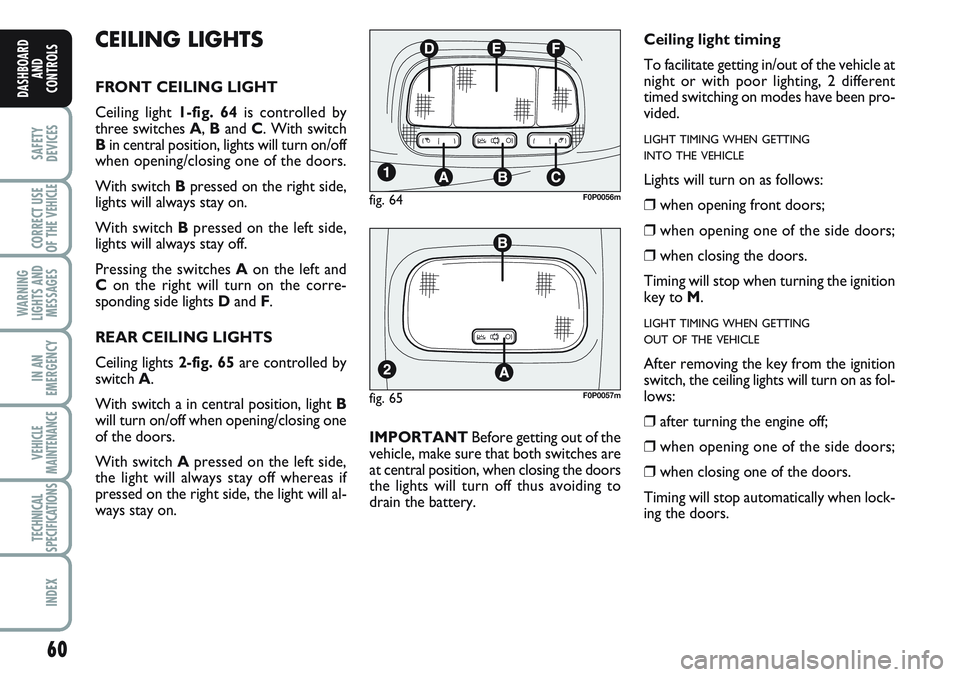
60
SAFETY
DEVICES
CORRECT USE
OF THE
VEHICLE
WARNING
LIGHTS AND
MESSAGES
IN AN
EMERGENCY
VEHICLE
MAINTENANCE
TECHNICAL
SPECIFICATIONS
INDEX
DASHBOARD
AND
CONTROLS
CEILING LIGHTS
FRONT CEILING LIGHT
Ceiling light 1-fig. 64is controlled by
three switches A, Band C. With switch
Bin central position, lights will turn on/off
when opening/closing one of the doors.
With switch Bpressed on the right side,
lights will always stay on.
With switch Bpressed on the left side,
lights will always stay off.
Pressing the switches Aon the left and
Con the right will turn on the corre-
sponding side lights Dand F.
REAR CEILING LIGHTS
Ceiling lights 2-fig. 65are controlled by
switch A.
With switch a in central position, light B
will turn on/off when opening/closing one
of the doors.
With switch Apressed on the left side,
the light will always stay off whereas if
pressed on the right side, the light will al-
ways stay on.IMPORTANTBefore getting out of the
vehicle, make sure that both switches are
at central position, when closing the doors
the lights will turn off thus avoiding to
drain the battery.
fig. 65F0P0057m
Ceiling light timing
To facilitate getting in/out of the vehicle at
night or with poor lighting, 2 different
timed switching on modes have been pro-
vided.
LIGHT TIMING WHEN GETTING
INTO THE VEHICLE
Lights will turn on as follows:
❒when opening front doors;
❒when opening one of the side doors;
❒when closing the doors.
Timing will stop when turning the ignition
key to M.
LIGHT TIMING WHEN GETTING
OUT OF THE VEHICLE
After removing the key from the ignition
switch, the ceiling lights will turn on as fol-
lows:
❒after turning the engine off;
❒when opening one of the side doors;
❒when closing one of the doors.
Timing will stop automatically when lock-
ing the doors.
fig. 64F0P0056m
Page 66 of 219
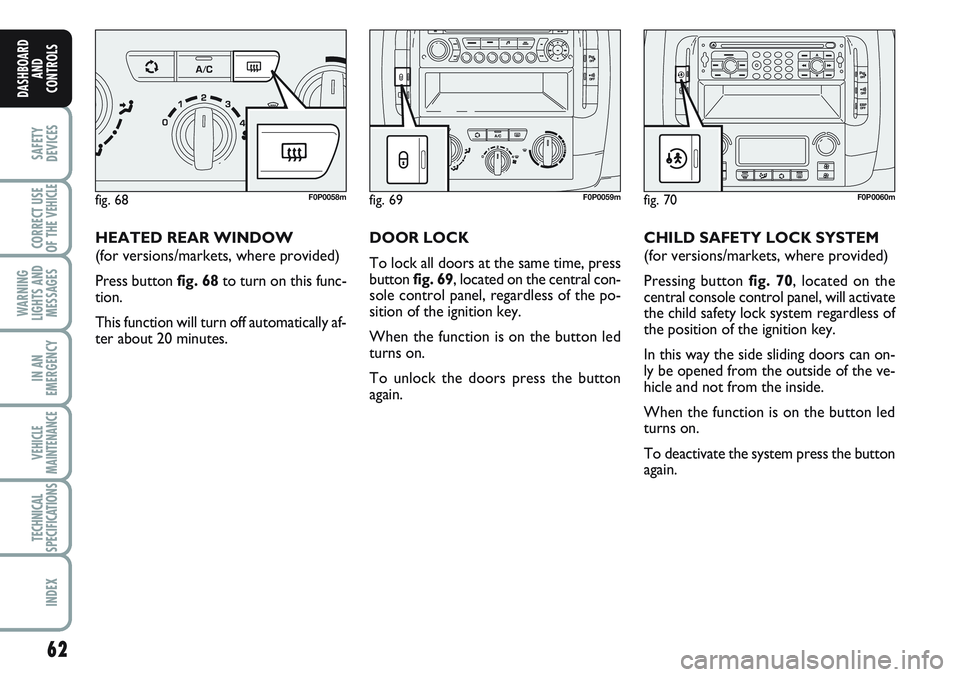
62
SAFETY
DEVICES
CORRECT USE
OF THE
VEHICLE
WARNING
LIGHTS AND
MESSAGES
IN AN
EMERGENCY
VEHICLE
MAINTENANCE
TECHNICAL
SPECIFICATIONS
INDEX
DASHBOARD
AND
CONTROLS
HEATED REAR WINDOW
(for versions/markets, where provided)
Press button fig. 68to turn on this func-
tion.
This function will turn off automatically af-
ter about 20 minutes.DOOR LOCK
To lock all doors at the same time, press
button fig. 69, located on the central con-
sole control panel, regardless of the po-
sition of the ignition key.
When the function is on the button led
turns on.
To unlock the doors press the button
again.CHILD SAFETY LOCK SYSTEM
(for versions/markets, where provided)
Pressing button fig. 70, located on the
central console control panel, will activate
the child safety lock system regardless of
the position of the ignition key.
In this way the side sliding doors can on-
ly be opened from the outside of the ve-
hicle and not from the inside.
When the function is on the button led
turns on.
To deactivate the system press the button
again.
fig. 68F0P0058mfig. 69F0P0059mfig. 70F0P0060m
Page 67 of 219
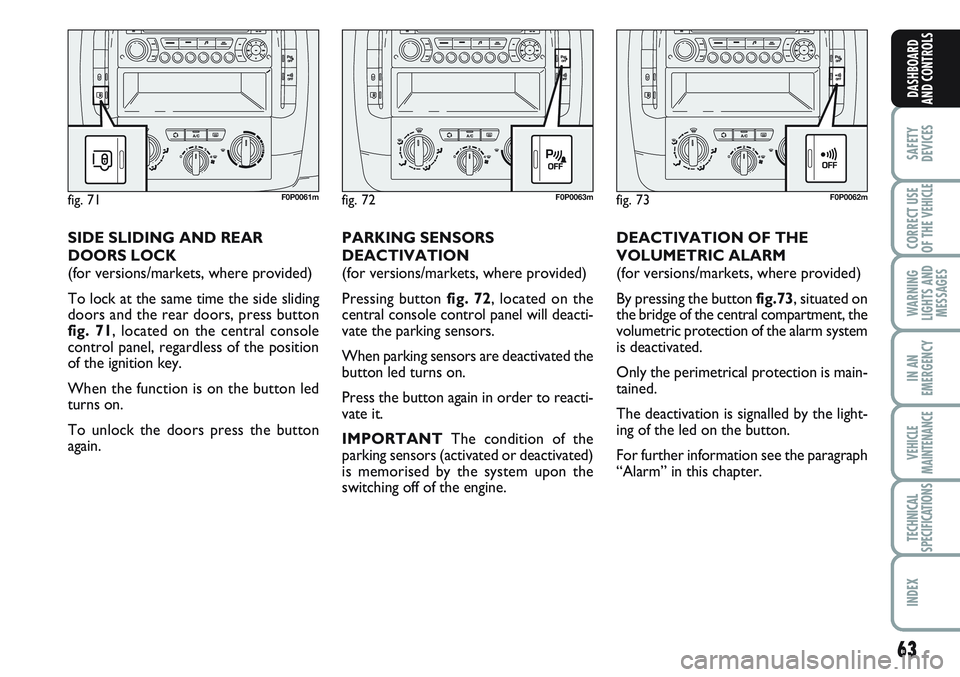
63
SAFETY
DEVICES
CORRECT USE
OF THE
VEHICLE
WARNING
LIGHTS AND
MESSAGES
IN AN
EMERGENCY
VEHICLE
MAINTENANCE
TECHNICAL
SPECIFICATIONS
INDEX
DASHBOARD
AND CONTROLS
DEACTIVATION OF THE
VOLUMETRIC ALARM
(for versions/markets, where provided)
By pressing the button fig.73, situated on
the bridge of the central compartment, the
volumetric protection of the alarm system
is deactivated.
Only the perimetrical protection is main-
tained.
The deactivation is signalled by the light-
ing of the led on the button.
For further information see the paragraph
“Alarm” in this chapter.
fig. 72F0P0063m
PARKING SENSORS
DEACTIVATION
(for versions/markets, where provided)
Pressing button fig. 72, located on the
central console control panel will deacti-
vate the parking sensors.
When parking sensors are deactivated the
button led turns on.
Press the button again in order to reacti-
vate it.
IMPORTANTThe condition of the
parking sensors (activated or deactivated)
is memorised by the system upon the
switching off of the engine.
fig. 73F0P0062m
SIDE SLIDING AND REAR
DOORS LOCK
(for versions/markets, where provided)
To lock at the same time the side sliding
doors and the rear doors, press button
fig. 71, located on the central console
control panel, regardless of the position
of the ignition key.
When the function is on the button led
turns on.
To unlock the doors press the button
again.
fig. 71F0P0061m
Page 69 of 219
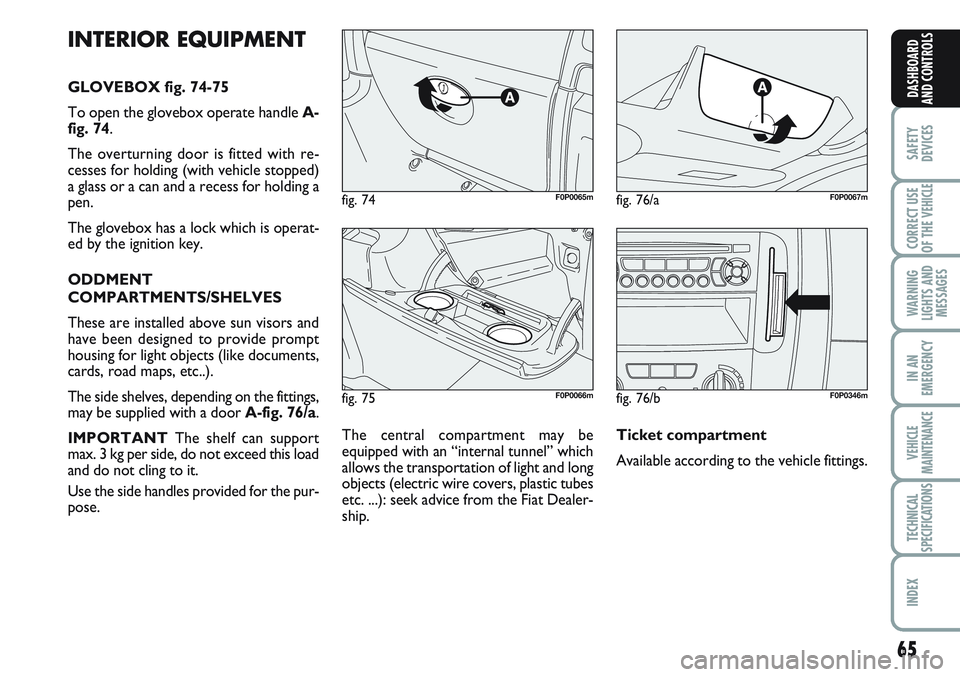
65
SAFETY
DEVICES
CORRECT USE
OF THE
VEHICLE
WARNING
LIGHTS AND
MESSAGES
IN AN
EMERGENCY
VEHICLE
MAINTENANCE
TECHNICAL
SPECIFICATIONS
INDEX
DASHBOARD
AND CONTROLS
fig. 75F0P0066m
fig. 74F0P0065mfig. 76/aF0P0067m
INTERIOR EQUIPMENT
GLOVEBOX fig. 74-75
To open the glovebox operate handle A-
fig. 74.
The overturning door is fitted with re-
cesses for holding (with vehicle stopped)
a glass or a can and a recess for holding a
pen.
The glovebox has a lock which is operat-
ed by the ignition key.
ODDMENT
COMPARTMENTS/SHELVES
These are installed above sun visors and
have been designed to provide prompt
housing for light objects (like documents,
cards, road maps, etc..).
The side shelves, depending on the fittings,
may be supplied with a doorA-fig. 76/a.
IMPORTANT The shelf can support
max. 3 kg per side, do not exceed this load
and do not cling to it.
Use the side handles provided for the pur-
pose.The central compartment may be
equipped with an “internal tunnel” which
allows the transportation of light and long
objects (electric wire covers, plastic tubes
etc. ...): seek advice from the Fiat Dealer-
ship.
fig. 76/bF0P0346m
Ticket compartment
Available according to the vehicle fittings.
Page 73 of 219
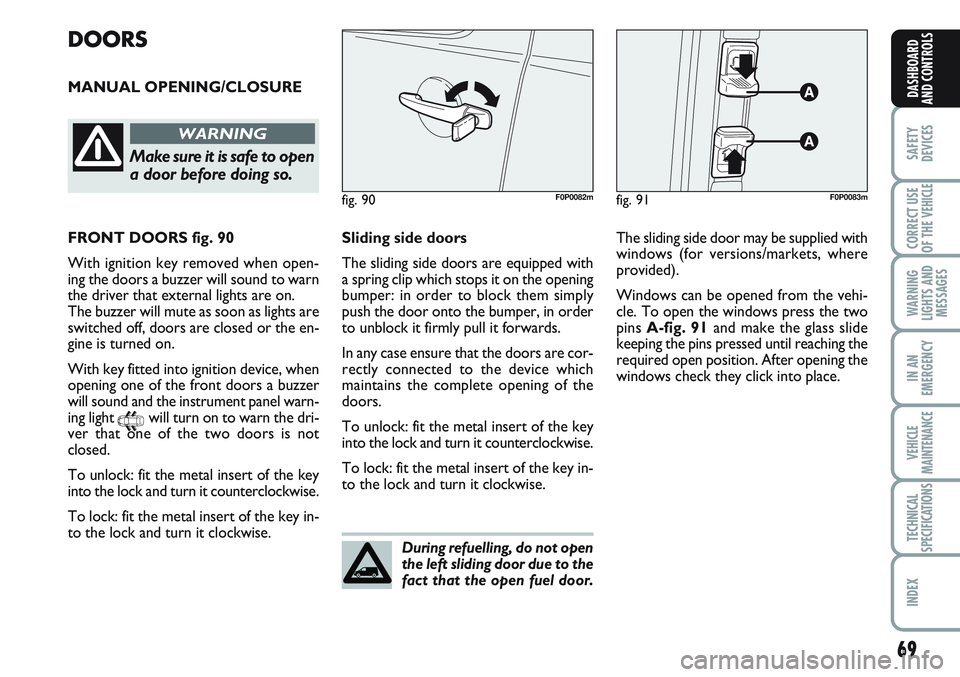
69
SAFETY
DEVICES
CORRECT USE
OF THE
VEHICLE
WARNING
LIGHTS AND
MESSAGES
IN AN
EMERGENCY
VEHICLE
MAINTENANCE
TECHNICAL
SPECIFICATIONS
INDEX
DASHBOARD
AND CONTROLS
DOORS
MANUAL OPENING/CLOSURE
fig. 91F0P0083mfig. 90F0P0082m
Make sure it is safe to open
a door before doing so.
WARNING
FRONT DOORS fig. 90
With ignition key removed when open-
ing the doors a buzzer will sound to warn
the driver that external lights are on.
The buzzer will mute as soon as lights are
switched off, doors are closed or the en-
gine is turned on.
With key fitted into ignition device, when
opening one of the front doors a buzzer
will sound and the instrument panel warn-
ing light
9will turn on to warn the dri-
ver that one of the two doors is not
closed.
To unlock: fit the metal insert of the key
into the lock and turn it counterclockwise.
To lock: fit the metal insert of the key in-
to the lock and turn it clockwise.Sliding side doors
The sliding side doors are equipped with
a spring clip which stops it on the opening
bumper: in order to block them simply
push the door onto the bumper, in order
to unblock it firmly pull it forwards.
In any case ensure that the doors are cor-
rectly connected to the device which
maintains the complete opening of the
doors.
To unlock: fit the metal insert of the key
into the lock and turn it counterclockwise.
To lock: fit the metal insert of the key in-
to the lock and turn it clockwise.The sliding side door may be supplied with
windows (for versions/markets, where
provided).
Windows can be opened from the vehi-
cle. To open the windows press the two
pins A-fig. 91and make the glass slide
keeping the pins pressed until reaching the
required open position. After opening the
windows check they click into place.
During refuelling, do not open
the left sliding door due to the
fact that the open fuel door.